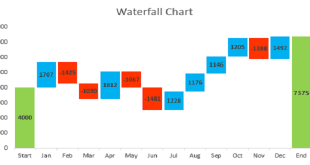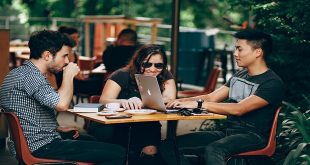Creating a landing page for mobile users is a necessity. It’s not just a valuable addition. It can be the difference between a successful marketing campaign and one that falls flat.
Don’t believe us? According to Statista, there are about 7.1 billion mobile users globally. And most of them have bought something online through their smartphones. Be that a physical product or a digital one.
The number of mobile users is only going to grow. So, it’s time to start thinking about how you will reach them. One way to do that is by creating a landing page designed specifically for mobile users.
However, building the perfect landing page for mobile users isn’t always easy. It takes time, effort, and a lot of testing. For a bit of help, here’s how you can design mobile landing pages that boost conversion rates, reduce bounce rates, and work magic for lead generation.
Set a fixed navigation menu
We are now living in a mobile-first world. There’s no more denying it. The stats speak for themselves:
- More than 60% of web traffic now comes from mobile devices, and that number is only going to increase.
- About 70% of Internet users use shopping applications on their smartphones.
Google has shifted to a mobile-first index. That means Google ranks websites based on UX, relevance, and mobile content. And your mobile navigation contributes to those factors. Plus, it must work for SEO and for users.
Easy and quick mobile navigation makes it effortless for your site visitors to find what they’re looking for without cluttering the screen or bogging down page speed. The best way to achieve that is to have a fixed or “sticky” navigation menu.
A sticky navigation bar stays with the user as they scroll down the page. It’s always visible, so users don’t have to scroll back to the top of the page every time they want to click a new link.
And this is especially important on mobile devices, where it can be easy to lose your place on a long web page. This feeling will trigger a high bounce rate, which is something you want to avoid at all costs.
Now that we’ve pointed out the importance of sticky navigation, how can your landing pages use it to their full potential?
Here are a few tips:
- Use a simple design. The fewer elements, the better.
- Stick to the essentials. Include only the links that are most important to your visitors, such as your home page, product pages, and contact information.
- Make it easy to use. Design your sticky nav so that it’s easy to click on links.
- Consider your branding. Your sticky nav is an opportunity to reinforce your brand identity with every click. Use your brand colors, logo, and font to create a cohesive experience.
- Make it easy to find. Place the menu in a prominent position, preferably at the top of the page.
- Use large font sizes. Mobile users are often trying to navigate quickly, so make sure they can see your links.
- Make menus collapsible. When users click on a link, the menu should collapse so they can focus on the content. Since mobile phones have limited space, you’ll want to maximize the screen real estate.
A sticky navigation menu will undoubtedly make your mobile landing pages more effective and can help you improve your conversion rate. If you’re not using one already, now is the time to implement this change. Your visitors (and your business) will thank you for it.
Use a single-column layout web design
One of the best and most appealing ways to display content on mobile is to use a single-column layout. It will make your content easily scannable and readable on any device. By using a single-column layout, you can keep your readers engaged and minimize distractions.
Another great benefit of using a single-column layout is that it allows you to focus on one thing at a time. When you have too many things going on in your layout, it can be overwhelming for your readers. But with a single-column layout, you can simplify your design and make sure that your readers can focus on your content.
And that’s what you want your readers to do. Focus on what your landing page is about and maybe do something about it. For example, if you’re selling a product, you want your readers to buy it. If you’re promoting a service, you want your readers to sign up for it.
How can you implement a single-column layout for mobile users? You can use responsive design to implement a single-column layout for mobile users. Responsive design is an approach to web design that makes your web pages look good on all devices. It’s about using HTML and CSS to move, enlarge, shrink, hide, or resize the content to make it look good on any screen.
Common examples of a single-column layout on mobile are the Facebook app and Google Maps. Both of these apps use a single-column layout to display content on mobile devices.
If you can make your mobile landing pages display content in a single column, you will make them more user-friendly and increase the chances of getting the results that you want. If you need assistance, our Website Design Services can help you with this.
Implement the SEO (search engine optimization) basics
Landing pages are designed to drive conversion and are a key part of your SEO strategy. If you want your landing pages to rank in Google, you need to make sure you’re implementing the SEO basics.
Having a landing page that does not do well in the local search results and can’t be found is a wasted opportunity. If no one can find it, you won’t get conversions.
Keep in mind that effective landing pages attract more organic traffic and the right people. In particular, those who are likely interested in your offerings. Hence, they are more likely to convert.
Have a solid keyword strategy
The foundation or bedrock of a successful landing page is a robust keyword strategy. First, you’ll need to identify the right keywords for your business. And you can do this by looking at your Google Analytics account to see which keywords are already driving traffic to your site.
You can also use a tool like Google AdWords Keyword Planner to find new keywords related to your business. Once you’ve identified the right keywords, you need to include them in the following places on your landing page:
- Title
- Headings
- Meta tags
- Content
- URL
By including the right keywords on your landing page, you’re making it easier for Google to understand what your page is about. And when Google understands your page, it’s more likely to rank in the search results.
Understand your content’s structure
Take note that it takes more than keywords to optimize a landing page. The structure of your content also plays a role in how well your page will rank.
One way to make sure your content is properly structured is to use the Heading tags. These are HTML tags that tell Google what the hierarchy of your content is. The top-level heading is the H1 tag, and subsequent subheadings are H2-H6 tags.
It’s important to use these tags correctly, as they can help Google understand the structure of your page. For instance, if you have a heading that says “SEO Basics” and a subheading that says “How to Optimize Your Landing Page,” Google will understand that the subheading is related to the heading.
This is important because it tells Google what your page is about and how it’s organized. When Google understands your page, it’s more likely to rank in the search results.
Optimize your landing page URL
The URL of your landing page is also important for SEO. A properly optimized URL should:
- Be short and to the point
- Include your target keyword
- Use dashes to separate words
For instance, a URL for a landing page about “SEO basics” might look like this: example.com/seo-basics.
As you can see, the URL includes the target keyword (“SEO basics”) and is short and to the point. And this makes it easy for Google to understand what the page is about and makes it more likely to rank in the search results.
Build backlinks
Backlinks or external links are links from other websites to your landing page. And they’re important for SEO because they help Google understand what websites are talking about your page.
For instance, if a lot of websites are linking to your landing page about “SEO basics,” Google will understand that your page is a good resource for that topic. And this makes it more likely to rank in the search results.
So, how do you get backlinks? There are a few ways:
- Reach out to other website owners and ask them to link to your page
- Submit your website to directories
- Write guest posts on other websites and include a link back to your site
By building backlinks, you’re making it easier for Google to understand what websites are talking about your page. And when Google understands your page, it’s more likely to rank in the search results.
In general, the more backlinks you have, the better. But it’s not just the quantity of backlinks that is important; it’s also the quality. So, you should focus on getting backlinks from high-quality websites.
Write local and unique content
You shouldn’t write content just because or to fill up space on your website. Every sentence, paragraph, and the page should have a purpose. That purpose could be to educate your readers, entertain them, or even just get them thinking about a specific topic. But whatever the purpose is, make sure it’s relevant to your local audience.
Local Keywords
One of the essential components of location-specific content is local keywords. They are the words and phrases that potential customers in your area use when searching for businesses like yours. Therefore, the best search terms to use when writing local landing page content are geo-targeted keywords, high search volume, and relevance to the business.
Use Google Keyword Planner to find local keywords relevant to your business. Simply enter a seed keyword into the tool, and it will return a list of related terms and phrases and their monthly search volume.
Headlines
Because your local audience will be finding your content on a small screen, you must have headlines that are clear and to the point. In addition, ensure that your headline incorporates the language that your target market is using in their searches and accurately reflects the page’s topic.
Your headlines should be:
- clear and concise
- reflective of the topic of the page
- use language that your target market is using in their searches
Copy
Again, since there’s limited real estate on mobile devices, your copy needs to be well-written and free of fluff. Every sentence should serve a purpose, so get rid of anything that doesn’t add value.
Be sure to:
- write clear and concise copy
- use language that your target market is using in their searches
- focus on the benefits to the reader, not the features of the product or service
- use short paragraphs and sentences
Images
Mobile users are more likely to engage with content that includes images, so it’s essential to have at least one image on each page of your website. The image should be relevant to the topic of the page and help tell the story you’re trying to communicate.
To ensure that your images are mobile-friendly, be sure to:
- optimize your images for fast loading times
- use images that are relevant to the topic of the page
- make sure the image is of good quality
When it comes to local content, remember that quality trumps quantity. So long as your content is well-written and relevant to your local audience, you’ll be on your way to driving more traffic to your website.
Mention your contact details
If you want your mobile landing page to be as effective and successful as possible, you need to make sure that you include your contact details. It may seem like an obvious thing, but you would be surprised at how many people forget to include their phone number or email address.
So, how can you make sure that your contact details are prominently displayed on your mobile landing page? Here are a few tips:
- Use large, easy-to-read font sizes
- Place your contact details in a prominent position on the page
- Use icons or buttons to make it easy for visitors to click through to your contact details
And be consistent! Ensure that the contact details you include on your mobile landing page are the same as those you use on your website and other digital marketing materials.
Consider load time
Mobile landing page speed is critical. The longer your audience has to wait, the more likely they will leave. In fact, 40% of people will abandon a website that takes longer than three seconds to load. Therefore, reducing your page load time can significantly impact your conversion rate.
There are a few things you can do to reduce your page load time:
- Use a content delivery network (CDN).
- Optimize your images.
- Minimize your redirects.
- Enable browser caching.
Speed is everything, especially for mobile users. You can improve your conversion rate by reducing your page load time and keeping your audience happy.
Add a call-to-action button
Ideally, your CTAs must be one of the first elements your audience sees. When they’re visible and prominent, they can serve as beacons that guide users to your most important content.
Make sure your CTA button is placed:
- Above the fold
- On the left side of the page
- Near relevant images or text
Your CTA button should stand out from the rest of your page elements by:
- Being a different color than the rest of your page
- Including an arrow or other directional cue
- Using action-oriented language like “Download,” “Sign Up,” or “Learn More”
- Don’t forget to test different colors, sizes, and positions for your CTA button to see what works best for your audience and your business
What’s more, ensure to make your CTAs as solid and immediate as possible, one that makes your visitors want to click on them right away.
Conclusion
Creating a successful local landing page for mobile users can be tricky, but it’s essential to get it right to convert leads into customers. We hope that the tips and examples we’ve shared have given you some ideas on how to create your local landing page.
Remember, always test your pages before going live and be sure to track results so you can continue to improve your page and see increased conversions. If you need help designing or optimizing your custom website, contact us.
We are a website design agency Los Angeles offering web development and web design services. We can help you create a landing page that helps you achieve your business goals or next web design project with our professional web designers. Schedule a call with our web design company today!





